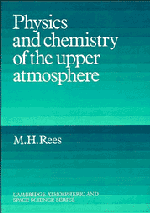Book contents
- Frontmatter
- Contents
- Preface
- Acknowledgements
- 1 An overview
- 2 The interaction of energetic solar photons with the upper atmosphere
- 3 The interaction of energetic electrons and ions with the upper atmosphere
- 4 Collisions and reactions
- 5 Ion and neutral composition of the upper atmosphere
- 6 Temperatures in the upper atmosphere
- 7 Spectroscopic emissions
- 8 Dynamics of the thermosphere and ionosphere
- Appendices
- 1 The neutral atmosphere
- 2 The solar irradiance and photon cross sections
- 3 Energy level diagrams and potential curves
- 4 Cross sections for collisions between energetic electrons, protons and atoms and the major atmospheric gases
- 5 Chemical/ionic reactions in the thermosphere
- 6 Transport coefficients, polarizability, collision frequencies, and energy transfer rates
- 7 Physical constants and units
- Index
- Frontmatter
- Contents
- Preface
- Acknowledgements
- 1 An overview
- 2 The interaction of energetic solar photons with the upper atmosphere
- 3 The interaction of energetic electrons and ions with the upper atmosphere
- 4 Collisions and reactions
- 5 Ion and neutral composition of the upper atmosphere
- 6 Temperatures in the upper atmosphere
- 7 Spectroscopic emissions
- 8 Dynamics of the thermosphere and ionosphere
- Appendices
- 1 The neutral atmosphere
- 2 The solar irradiance and photon cross sections
- 3 Energy level diagrams and potential curves
- 4 Cross sections for collisions between energetic electrons, protons and atoms and the major atmospheric gases
- 5 Chemical/ionic reactions in the thermosphere
- 6 Transport coefficients, polarizability, collision frequencies, and energy transfer rates
- 7 Physical constants and units
- Index
Summary
Empirical models are constructed from a large data base of observations made in situ by satellite borne mass spectrometers and remotely from the ground. Minimum perigee for long-lived satellites is at about 150 km, depending on the available on-board propulsion system. Data points below this altitude are therefore inferred from incoherent scatter radar measurements, which also serve to follow the temporal variation of several parameters at one location. Satellites provide the global coverage.
One such empirical model is based on decades of accumulated measurements acquired by several low-altitude orbiting satellites and radar measurements. It has been updated periodically and the most recent version is the MSIS-86. The large number of individual measurements allowed binning by geographic position and universal time, solar zenith angle, solar activity and geomagnetic activity.
The parameters computed by the empirical model as a function of altitude are the concentrations of N2, O, O2, H, He, Ar, N, the mass density and the neutral temperature. The data sets provided here correspond to the solar minimum (July 1976) and solar maximum (February 1979) periods used as examples in Chapter 2, as well as day 23 April, 1974 on which the solar irradiance reference spectrum for the Atmosphere Explorer satellite was acquired by a rocket payload.
- Type
- Chapter
- Information
- Physics and Chemistry of the Upper Atmosphere , pp. 243 - 255Publisher: Cambridge University PressPrint publication year: 1989

